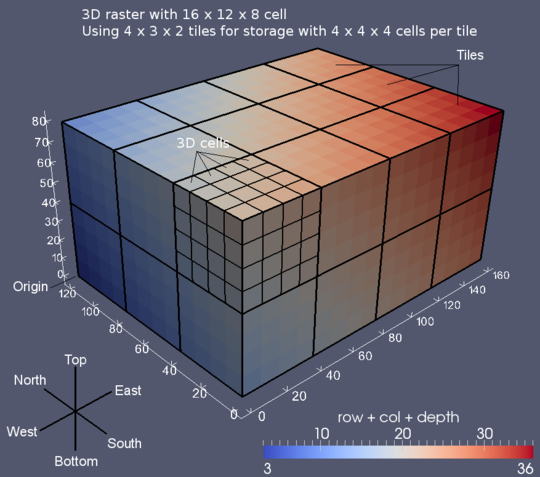DESCRIPTION
r3.in.ascii allows a user to create a (binary) GRASS 3D raster map
layer from a 3D ASCII raster input file.
The tiledimension parameter defines the dimension of the tiles
used in the output file. The format is: XxYxZ
The nv parameter specifies which value to convert to NULL-value.
If the specified value is none, no conversion is performed.
Default is none.
NOTES
The data is automatically imported into the correct internal coordinate system,
that is visualized in the following picture, independently from the specified
ordering in the ASCII input file:

|
The volume coordinate system and tile layout of the imported voxel map
|
NOTES
The format of the 3D ASCII file:
version: "grass7"
order: "nsbt" or "nstb" or "snbt" or "sntb"
north: floating point
south: floating point
east: floating point
west: floating point
top: floating point
bottom: floating point
rows: integer
cols: integer
levels: integer
The version and order options are not mandatory. In case no version and
order option is specified, the default GRASS 6 ASCII format is assumed.
This header is followed by the cell values in floating point format
organized in rows with constant col and level coordinate.
The rows are organized by constant level coordinate. Individual cell
values are separated by space or CR.
EXAMPLES
4x3x2 sample. Note in case no specific ordering is specified in the input
file the upper-left (NW) corner of the bottom level comes first. The according
order option is: nsbt for north -> south, bottom -> top ordering. This is
identical with r.in.ascii for single level data. So the y coordinate
is 0 at the northern edge.
north: 3.0
south: 0.0
east: 4.0
west: 0.0
top: 2.0
bottom: 0.0
rows: 3
cols: 4
levels: 2
w111x1,y1,z1 w211x2,y1,z1 w311x3,y1,z1 w411x4,y1,z1
w121x1,y2,z1 w221x2,y2,z1 w321x3,y2,z1 w421x4,y2,z1
w131x1,y3,z1 w231x2,y3,z1 w331x3,y3,z1 w431x4,y3,z1
w112x1,y1,z2 w212x2,y1,z2 w312x3,y1,z2 w412x4,y1,z2
w122x1,y2,z2 w222x2,y2,z2 w322x3,y2,z2 w422x4,y2,z2
w132x1,y3,z2 w232x2,y3,z2 w332x3,y3,z2 w432x4,y3,z2
Note that unit tests for r3.in.ascii are implemented in the
test.r3.out.ascii.sh script located in the
r3.out.ascii directory.
EXAMPLES
Please refer to the detailed examples in
r3.out.ascii.
AUTHORS
Roman Waupotitsch, Michael Shapiro,
Helena Mitasova, Bill Brown, Lubos Mitas, Jaro Hofierka, Sören Gebbert
SEE ALSO
r.in.ascii,
r3.out.ascii,
v.to.rast3,
g.region
Last changed: $Date$

